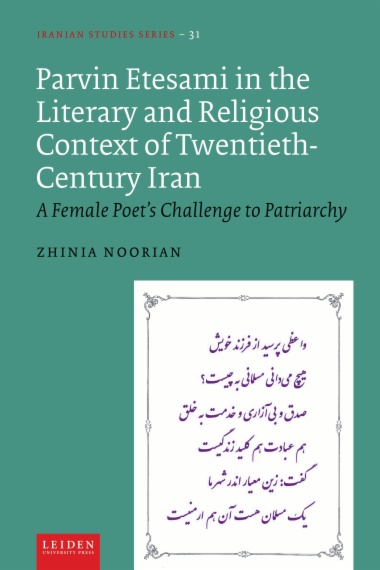Parvin E’tesami (1907-1941) is among the few Persian female poets, who has gained nationwide popularity, while her authorship was disbelieved. She is celebrated in a plethora of publications every year in Iran and beyond. E’tesami is the only female poet who has remained part of the daily lives of people in her society for about a century. Her poetry appears in school curricula both before and after the Revolution of 1979. People use her poetry on social media, particularly in critical times. It is also used in public speeches by Ali Khamenei (r. 1989-present) the supreme leader of the Islamic Republic. This book engages with E’tesami in the transformational context of the early twentieth century in Iran to investigate the controversies around her identity as a popular female poet. It demonstrates that the reason for E’tesami’s paradoxical popularity was not merely her gender, but the transgression of patriarchal Iranian-Muslim gender norms.
- Cover
- Table of Contents
- A Note on Translation, Transliteration and Footnotes
- Acknowledgments
- Introduction
- A Historical-Cultural Context
- Parvīn Iᶜtiṣāmī’s Life
- Parvīn Iᶜtiṣāmī’s Poetry
- Literature Review
- Research on Parvīn Iᶜtiṣāmī outside Iran
- Studying Parvīn Iᶜtiṣāmī in Iran
- Gaps in Previous Studies
- Research Question
- Conceptual Framework and Methodology
- Organisation of Chapters
- Chapter One. The Conundrum of Parvīn Iᶜtiṣāmī’s Authorship
- Muslim–Iranian Gender Norms
- Writing and Publishing: Acts of Transgression
- The Obligations of Femininity
- As Feminine As a ‘Woman’
- Transgressing Gender Norms
- Conclusion
- Chapter Two. Munāẓara: Parvīn Iᶜtiṣāmī’s Mirror of Transgressive Innovations
- Persian munāẓara: A Historical Background
- Asadī’s Munāẓaras: A Brief Survey
- An Introduction to Parvīn’s Munāẓaras
- Parvīn’s Religiosity
- ‘God’s Weaver’: An Investigation
- Conclusion
- Chapter 3. Parvīn Iᶜtiṣāmī’s Socio-political Engagement
- Introduction
- Socio-political Backdrop of Parvīn’s Life
- Constitutional Revolution (1905–1911)
- Re-establishment of Monarchy: The Pahlavi Regime
- Introduction of Socio-political Themes into Persian Poetry
- Socio-political Themes in Parvīn’s Poetry: A Backdrop
- Female Emancipation
- ‘Sapling of Hope’
- ‘Women in Iran’
- Social Justice
- Criticism of the State
- ‘Thief and Judge’
- ‘Drunk and Sober’126
- A Mystical Interpretation
- Socio-political Implications
- Conclusion
- Chapter 4. Parvīn Iᶜtiṣāmī’s Reception History: From Patronisation to School Curricula
- Why is Parvīn Iᶜtiṣāmī Still Popular?
- A Reception History of Parvīn’s Mystic-didactic Poetry
- Classical Persian Poetry in School Curricula
- Parvīn’s Poetry in School Curricula
- Luṭf-i ḥaqq (‘God’s Grace’)74
- Saᶜī-yu ᶜamal (‘Endeavour and Action’)
- Dirakht-i bī-bar (‘Fruitless Tree’)
- Ārizū-yi parvāz (‘Longing to Fly’)
- Surūd-i khārkan (‘Thistle-collector’s Song’)
- Mast-u hushyār (‘Drunk and Sober’)
- Conclusion
- Chapter 5. Parvīn’s Poetry in Service of Contemporary Politics
- Ali Khamenei, Engrossed by Parvīn Iᶜtiṣāmī
- Conclusion
- Epilogue
- Appendix
- Notes
- Bibliography
- Primary Sources
- Secondary Sources
- Index

